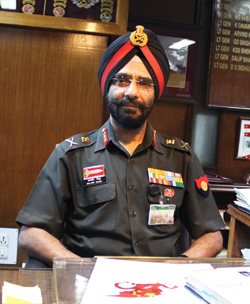INDIAN ARMED FORCES CHIEFS ON OUR RELENTLESS AND FOCUSED PUBLISHING EFFORTS

The insightful articles, inspiring narrations and analytical perspectives presented by the Editorial Team, establish an alluring connect with the reader. My compliments and best wishes to SP Guide Publications.

"Over the past 60 years, the growth of SP Guide Publications has mirrored the rising stature of Indian Navy. Its well-researched and informative magazines on Defence and Aerospace sector have served to shape an educated opinion of our military personnel, policy makers and the public alike. I wish SP's Publication team continued success, fair winds and following seas in all future endeavour!"

Since, its inception in 1964, SP Guide Publications has consistently demonstrated commitment to high-quality journalism in the aerospace and defence sectors, earning a well-deserved reputation as Asia's largest media house in this domain. I wish SP Guide Publications continued success in its pursuit of excellence.
- Prime Minister Modi Visits Punjab’s Adampur Air Base, Interacts with Airmen after Successful ‘Operation Sindoor’; Stern Message to Pakistan
- The layered Air Defence systems that worked superbly, the key element of Operation Sindoor
- Operation Sindoor | Day 2 DGMOs Briefing
- Operation Sindoor: India strikes back with Precision and Purpose
- Operation Sindoor: Resolute yet Restrained
- India’s Operation Sindoor Sends a Clear Message to Terror and the World – ‘ZERO TOLERANCE’
- Japan and India set forth a defence cooperation consultancy framework, talks on tank and jet engines
- Terrorist Attack in Pahalgam in Kashmir: Unfolding a long surgical war against PAK
- Lt General Pratik Sharma takes over Command of Indian Army's Northern Command
ĎI visualise a broader mandate for the Mechanised Forces in the futureí
In an exclusive Interview with SPís M.A.I., Lt General D.S. Siddhu, Director General Mechanised Forces, flags the modernisation and upgrading efforts of the Mechanised Forces of the Indian Army.

SPís M.A.I. (SPís): In the context of the future threats and challenges, have any new roles been defined for the Armoured Corps and the Mechanised Infantry?
Lt General D.S. Siddhu (DGMF): The security environment facing our nation is in a state of constant flux. There is a need for close monitoring of the changes taking place within and outside, especially in our close neighbourhood. We are constantly reviewing our military preparedness based on these changes. The Mechanised Forces need to constantly evolve, develop and adapt to the changing ďcapability cum threatĒ spectrum, in order to remain Ďoperationally relevantí at all points of time and to maintain the deterrence value.
I visualise a broader mandate for the Mechanised Forces in the future. We are likely to be employed in a broad spectrum of operational scenarios, ranging from operations in amphibious and mountainous terrain to various overseas deployments as part of an UN mandate. In addition, ever growing urbanisation has resulted in the likelihood of being involved in urban warfare and resultant consolidation operations.
SPís: What are the basic parameters which you consider essential and vital for designing the future MBT of the India Army?
DGMF: Based on the operational requirements, perspective planning and technologies available at present as well as in the future, the basic contours and the road map of the futuristic main battle tank (FMBT) have emerged. The preliminary staff qualitative requirement (PSQR) for the FMBT is evolved after taking the views of all the stakeholders. The efforts towards indigenisation/ absorption of transfer of technologies (ToT) and the lessons learnt play a major part in development of the FMBT.
SPís: What is the current status of procurement of light tank for the Indian Army?
DGMF: The relevance of armour has expanded from the erstwhile manoeuvre warfare to operations in difficult terrain, amphibious operations and fourth generation warfare. Consequently, a need has been felt to customise our equipment profile to meet the specialised requirement. To that effect, the light tank is being proposed to meet different operational requirements. Currently, doctrinal and technical issues are being deliberated. Thereafter, the qualitative requirements will be finalised.
SPís: Has any new equipment been planned for the reconnaissance troops and platoons of armoured regiments and mechanised infantry battalions respectively to make them more effective?
DGMF: The Indian Army is looking at the procurement of a light armoured vehicle designed to meet the requirements of the reconnaissance troops and platoons. This vehicle will have the required mobility and agility over all types of terrain as also survivability, it will be equipped to carry out reconnaissance tasks during day as well as night in all weather conditions. Electronic control displays will integrate all on board systems for ease of management and efficiency.
SPís: Russians have made the ICV BMP-3 which has a 100mm 2A70 semi-automatic rifled gun as its main armament fires an anti-tank guided missile from the same barrel. Is the IA planning for a future ICV on this pattern?
DGMF: BMP-3 though a versatile equipment, but its physical attributes impinge on its deployment and floatation capability. Indian Army has planned for a futuristic infantry combat vehicle (FICV) to replace the BMP-2 with key operational and performance parameters envisaged in the Indian context. The project is a pioneer in ĎMake Hi-Techí category where for the first time the defence industry has invited participation by private established agencies. The project is in an advance stage for development of a prototype. We are of the view that our operational requirements can be met with a weapon mix of a cannon, machine gun, missile firing capability and an automatic grenade launcher.





